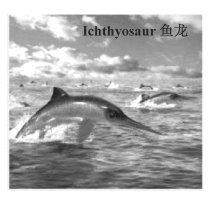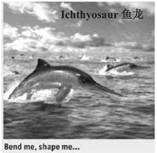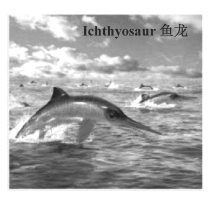-
If a diver surfaces too quickly, he may suffer the bends. Nitrogen(氮) dissolved(溶解) in his blood is suddenly liberated by the reduction of pressure. The consequence, if the bubbles (气泡)accumulate in a joint, is sharp pain and a bent body—thus the name. If the bubbles form in his lungs or his brain, the consequence can be death.

Other air-breathing animals also suffer this decompression(减压) sickness if they surface too fast: whales, for example. And so, long ago, did ichthyosaurs. That these ancient sea animals got the bends can be seen from their bones. If bubbles of nitrogen form inside the bone they can cut off its blood supply. This kills the cells in the bone, and consequently weakens it, sometimes to the point of collapse. Fossil (化石)bones that have caved in on them selves are thus a sign that the animal once had the bends.
Bruce Rothschild of the University of Kansas knew all this when he began a study of ichthyosaur bones to find out how widespread the problem was in the past. What he particularly wanted to investigate was how ichthyosaurs adapted to the problem of decompression over the 150 million years. To this end, he and his colleagues traveled the world’s natural-history museums, looking at hundreds of ichthyosaurs from the Triassic period and from the later Jurassic and Cretaceous periods.
When he started, he assumed that signs of the bends would be rarer in younger fossils, reflecting their gradual evolution of measures to deal with decompression. Instead, he was astonished to discover the opposite. More than 15% of Jurassic and Cretaceous ichthyosaurs had suffered the bends before they died, but not a single Triassic specimen(标本) showed evidence of that sort of injury.
If ichthyosaurs did evolve an anti-decompression means, they clearly did so quickly—and, most strangely, they lost it afterwards. But that is not what Dr Rothschild thinks happened. He suspects it was evolution in other animals that caused the change.
Whales that suffer the bends often do so because they have surfaced to escape a predator (捕食动物) such as a large shark. One of the features of Jurassic oceans was an abundance of large sharks and crocodiles, both of which were fond of ichthyosaur lunches. Triassic oceans, by contrast, were mercifully shark- and crocodile-free. In the Triassic, then, ichthyosaurs were top of the food chain. In the Jurassic and Cretaceous, they were prey(猎物) as well as predator—and often had to make a speedy exit as a result.
1.Which of the following is a typical symptom of the bends?
A. A twisted body. B. A gradual decrease in blood supply.
C. A sudden release of nitrogen in blood. D. A drop in blood pressure.
2.The purpose of Rothschild’s study is to see________ .
A. how often ichthyosaurs caught the bends B. how ichthyosaurs adapted to decompression
C. why ichthyosaurs bent their bodies D. when ichthyosaurs broke their bones
3.Rothschild’sfindingstatedinParagraph4 .
A. confirmed his assumption B. speeded up his research process
C. disagreed with his assumption D. changed his research objectives
4.Rothschild might have concluded that ichthyosaurs.
A. failed to evolve an anti decompression means
B. gradually developed measures against the bends
C. died out because of large sharks and crocodiles
D. evolved an anti decompression means but soon lost it
高三英语阅读理解中等难度题查看答案及解析
-
If a diver surfaces too quickly, he may suffer the bends. Nitrogen (氮) dissolved (溶解) in his blood is suddenly liberated by the reduction of pressure. The consequence, if the bubbles (气泡) accumulate in a joint, is sharp pain and a bent body — thus the name. If the bubbles form in his lungs or brain, the consequence can be death.
Other air-breathing animals also suffer this decompression (减压) sickness if they surface too fast: whales, for example. And so, long ago, did ichthyosaurs (鱼龙). That these ancient sea-animals got the bends can be seen from their bones. If bubbles of nitrogen form inside the bone they can cut off its blood supply. This kills the cells in the bone, and consequently weakens it, sometimes to the point of collapse. Fossil(化石)bones that have caved in on themselves are thus a sign that the animal once had the bends.
Bruce Rothschild of the University of Kansas knew all this when he began a suty of ichthyosaurs bones to find out how widespread the problem was in the past. What he particularly wanted to investigate was how ichthyosaurs adapted to the problem of decompession over the 150 milllion years. To this end, he and his colleagues traveled the world’s natural-history museums, looking at hundreds of ichthyosaurs from the Trassic period and from the later Jurassic and Cretaceous periods.
When he started, he assumed that signs of the bends would be rarer in younger fossils, reflecting their gradual evolution of measures to deal with decompression. Instead, he was astonished to discover the opposite. More than 15% of Jurassic and Cretaceous ichthyosaurs had suffered the bends before the died, but not a single Trassic specimen showed evidence of that sort of injury.
If ichthyosaurs did evolve an anti-decompression means, they clearly did so quickly — and, most strangly, they lost it afterwards. But that is not what Dr Rothchild thinks happened. He suspects it was evolution in other animals that caused the change.
Whales that suffer the bends often do so because they have sufaced to escape a predator (捕食动物) such as a large shark. One of the features of the Jurassia oceans was an abundance of large sharks and crocodiles, both of which were fond of ichthyosaurs lunches. Trassic oceans, by contrast, were mercifully shark-and crocodile-free. In the Trassic, then, ichthyosaurs were top of the food chain. In the Jurrasic and Cretaceous, they were prey (猎物) as well as predator —and often had to make a speedy exit as a result.
1.Which of the following is a typical symptom of the bends?
A. A twisted body.
B. A gradual decrease in blood supply.
C. A sudden release of nitrogen in blood.
D. A drop in blood presure.
2.The purpose of Rothchild’s study is to see ________.
A. how often ichthyosaurs caught the bends
B. how ichthyosaurs adapted to decompression
C. why ichthyosaurs bent their bodies
D. when ichthyosaurs broke their bones
3.Rothchild’s finding stated in Paragrapg 4 ________.
A. confirmed his assumption B. speeded up his research process
C. disagreed with his assumption D. changed his research objectives
4.Rothchild might have concluded that ichthyosaurs ________.
A. failed to evole an anti-decompression means
B. grdually developed measures against the bends
C. died out because of large sharks and crocodiles
D. evoled an anti-decompression means but soon lost it
高三英语阅读理解中等难度题查看答案及解析
-

If a diver surfaces too quickly, he may suffer the bends. Nitrogen (氮) dissolved (溶解) in his blood is suddenly liberated by the reduction of pressure. The consequence, if the bubbles (气泡) accumulate in a joint, is sharp pain and a bent body—thus the name. If the bubbles form in his lungs or his brain, the consequence can be death.
Other air-breathing animals also suffer this decompression (减压) sickness if they surface too fast: whales, for example. And so, long ago, did ichthyosaurs. That these ancient sea animals got the bends can be seen from their bones. If bubbles of nitrogen form inside the bone they can cut off its blood supply. This kills the cells in the bone, and consequently weakens it, sometimes to the point of collapse. Fossil (化石) bones that have caved in on themselves are thus a sign that the animal once had the bends.
Bruce Rothschild of the University of Kansas knew all this when he began a study of ichthyosaur bones to find out how widespread the problem was in the past. What he particularly wanted to investigate was how ichthyosaurs adapted to the problem of decompression over the 150 million years. To this end, he and his colleagues traveled the world’s natural-history museums, looking at hundreds of ichthyosaurs from the Triassic period and from the later Jurassic and Cretaceous periods.
When he started, he assumed that signs of the bends would be rarer in younger fossils, reflecting their gradual evolution of measures to deal with decompression. Instead, he was astonished to discover the opposite. More than 15% of Jurassic and Cretaceous ichthyosaurs had suffered the bends before they died, but not a single Triassic specimen (标本) showed evidence of that sort of injury.
If ichthyosaurs did evolve an anti-decompression means, they clearly did so quickly—and, most strangely, they lost it afterwards. But that is not what Dr Rothschild thinks happened. He suspects it was evolution in other animals that caused the change.
Whales that suffer the bends often do so because they have surfaced to escape a predator (捕食动物) such as a large shark. One of the features of Jurassic oceans was an abundance of large sharks and crocodiles, both of which were fond of ichthyosaur lunches. Triassic oceans, by contrast, were mercifully shark- and crocodile-free. In the Triassic, then, ichthyosaurs were top of the food chain. In the Jurassic and Cretaceous, they were prey (猎物) as well as predator—and often had to make a speedy exit as a result.
1.Which of the following is a typical symptom of the bends?
A.A twisted body.
B.A gradual decrease in blood supply.
C.A sudden release of nitrogen in blood.
D.A drop in blood pressure.
2.The purpose of Rothschild’s study is to see ______.
A.how often ichthyosaurs caught the bends
B.how ichthyosaurs adapted to decompression
C.why ichthyosaurs bent their bodies
D.when ichthyosaurs broke their bones
3.Rothschild’s finding stated in Paragraph 4 ______.
A.confirmed his assumption B.speeded up his research process
C.disagreed with his assumption D.changed his research objectives
4.Rothschild might have concluded that ichthyosaurs ______.
A.failed to evolve an anti-decompression means
B.gradually developed measures against the bends
C.died out because of large sharks and crocodiles
D.evolved an anti-decompression means but soon lost it
高三英语阅读理解中等难度题查看答案及解析
-
If a diver surfaces too quickly, he may suffer the bends. Nitrogen(氮) dissolved(溶解) in his blood is suddenly liberated by the reduction of pressure. The consequence, if the bubbles (气泡)accumulate in a joint, is sharp pain and a bent body—thus the name. If the bubbles form in his lungs or his brain, the consequence can be death.

Other air-breathing animals also suffer this decompression(减压) sickness if they surface too fast: whales, for example. And so, long ago, did ichthyosaurs. That these ancient sea animals got the bends can be seen from their bones. If bubbles of nitrogen form inside the bone they can cut off its blood supply. This kills the cells in the bone, and consequently weakens it, sometimes to the point of collapse. Fossil (化石)bones that have caved in on them selves are thus a sign that the animal once had the bends.
Bruce Rothschild of the University of Kansas knew all this when he began a study of ichthyosaur bones to find out how widespread the problem was in the past. What he particularly wanted to investigate was how ichthyosaurs adapted to the problem of decompression over the 150 million years. To this end, he and his colleagues traveled the world’s natural-history museums, looking at hundreds of ichthyosaurs from the Triassic period and from the later Jurassic and Cretaceous periods.
When he started, he assumed that signs of the bends would be rarer in younger fossils, reflecting their gradual evolution of measures to deal with decompression. Instead, he was astonished to discover the opposite. More than 15% of Jurassic and Cretaceous ichthyosaurs had suffered the bends before they died, but not a single Triassic specimen(标本) showed evidence of that sort of injury.
If ichthyosaurs did evolve an anti-decompression means, they clearly did so quickly—and, most strangely, they lost it afterwards. But that is not what Dr Rothschild thinks happened. He suspects it was evolution in other animals that caused the change.
Whales that suffer the bends often do so because they have surfaced to escape a predator (捕食动物) such as a large shark. One of the features of Jurassic oceans was an abundance of large sharks and crocodiles, both of which were fond of ichthyosaur lunches. Triassic oceans, by contrast, were mercifully shark- and crocodile-free. In the Triassic, then, ichthyosaurs were top of the food chain. In the Jurassic and Cretaceous, they were prey(猎物) as well as predator—and often had to make a speedy exit as a result.
1.Which of the following is a typical symptom of the bends?
A.A twisted body. B.A gradual decrease in blood supply.
C.A sudden release of nitrogen in blood. D.A drop in blood pressure.
2.The purpose of Rothschild’s study is to see________ .
A.how often ichthyosaurs caught the bends B.how ichthyosaurs adapted to decompression
C.why ichthyosaurs bent their bodies D.when ichthyosaurs broke their bones
3.Rothschild’s finding stated in Paragraph 4________ ..
A.confirmed his assumption B.speeded up his research process
C.disagreed with his assumption D.changed his research objectives
4.Rothschild might have concluded that ichthyosaurs ________ .
A.failed to evolve an anti decompression means
B.gradually developed measures against the bends
C.died out because of large sharks and crocodiles
D.evolved an anti decompression means but soon lost it
高三英语阅读理解中等难度题查看答案及解析
-
He may not even drink water at night, _______ swallowing insects possibly floating on the surface.
A.in case of
B.for fear of
C.for the sake of
D.in line with
高三英语单项填空简单题查看答案及解析
-
It is often said that eyes can speak. In a bus you may look at g stranger, 1. not too long. If he notices that he is being stared at, he may feel 2. (comfort). It is the same in daily life. When you are 3. (look) at for several more times, you will look at yourself up and down to see if there is anything wrong 4. you. If nothing goes wrong, you 5. (feel) angry with the person who is looking at you. Eyes can speak, right?
6. (look) too long at someone may seem to be impolite. But sometimes things are different when it 7. (come) to staring at the opposite sex, if a man glances at a woman for more than ten seconds, his intentions are obvious, that is, he wishes to attract 8. (she ) attention, to make her understand that he is admiring her.
In fact, continuous eye contact is limited to 9. (love) only, who will enjoy looking at each other 10. (gentle ) for a long time,to show affection that words cannot express. Evidently, eye communication should be done according to the relationship between the two people.
高三英语短文填空中等难度题查看答案及解析
-
If only he _____ quietly as the doctor instructed, he would not suffer so much now.
A. would lie B. lay C. had lain D. should lie
高三英语单项填空困难题查看答案及解析
-
The cub(幼兽)learned quickly. If he met mother hen he would become angry, remembering the pecks on his nose from his first day out of a cave.
Famine came again and for a while, neither mother or cub had anything to eat. Then one day, She-wolf brought home some meat! It was strange stuff, different from anything the cub had smelled or tasted before. And it was for him! Little could he know that his mother had taken the left fork by the stream, by the lair of the lynx(山猫巢穴), and stolen kitten. As he finished his meal, he heard his mother snarling(咆哮)in strange and terrible way. He shivered with fear.
The lynx was mad with anger at the loss of her child and she had tracked She-wolf to her cave.
In the glare of the afternoon light, the lynx crouched at the cave entrance. A coarse scream left no doubt what she meant to do. The cub and his mother were trapped!
The lynx threw herself inside the cave, and She-wolf leaped upon her.
Snarling and howling, the two mothers fought like crazy, the lynx pulling and tearing with her teeth and claws, She-wolf using her teeth alone.
Seeing his mother in such danger, the cub sank his teeth into the wild cat’s leg. Although he didn’t know it, this is probably what saved their lives. The lynx beat at the cub, tearing his shoulder, but he had slowed her down. After a brief, cruel fight, She-wolf put an end to her once and for all.
They had won, but at a price.
The cub licked his mother’s wounds. He knew she was weak and sick. For a week she never left the cave.
Then at last, her strength returned and she was ready to hunt again. This time, the cub went with her. She-wolf noticed a change in her child. He had complete faith in himself from their victory over the lynx. They had fought a wild cat and lived!
The cub now knew another law of the wild-eat or to be eaten: kill or to be killed.
1.What can be inferred about the cub from Paragraph 1 and 2?
A.A mother hen once attacked him.
B.He shared the meat with She-wolf.
C.The cub didn’t like the strange meat.
D.He could obtain meat secretly.
2.Which of the following can replace the underlined word “crouched” in Paragraph 4?
A.Fought. B.Tracked. C.Hid. D.Trapped.
3.What mostly helped She-wolf and the cub win the fight against the lynx?
A.The lynx fighting with her teeth and claws.
B.The cub biting into the leg of the lynx.
C.The three being wounded seriously.
D.She-wolf using her sharp teeth.
4.What did the cub get from the victory?
A.Carefulness. B.Strength. C.Friendship. D.Confidence.
高三英语阅读理解中等难度题查看答案及解析
-
________ she was out of the room, he took a quick look at the papers on her desk.
A. If B. While C. Though D. Unless
高三英语单项填空中等难度题查看答案及解析
-
—May I speak to the patient now?
—No, you _____. He is too weak now.
A. needn’t B. may not C. mustn’t D. oughtn’t
高三英语单项填空中等难度题查看答案及解析